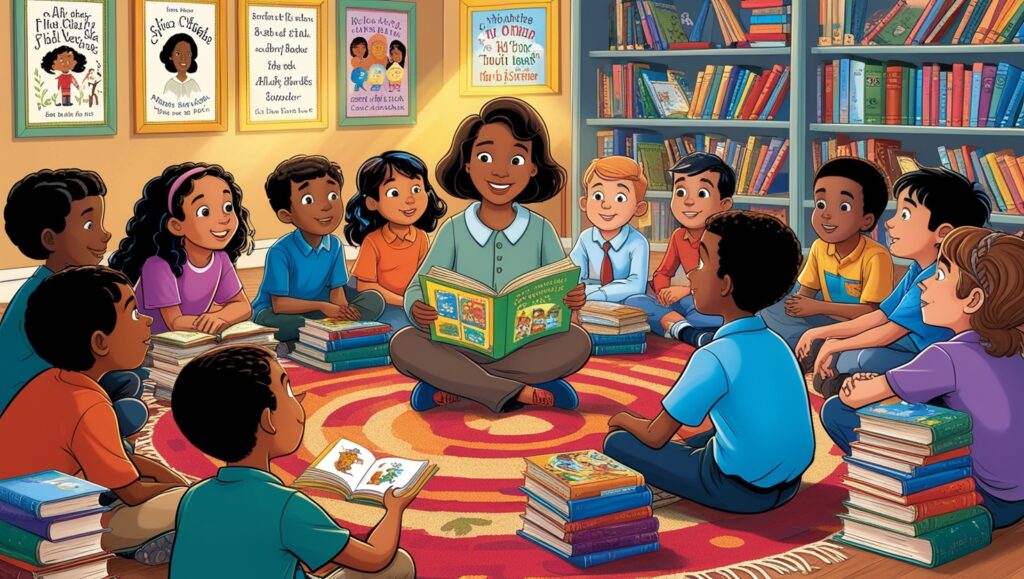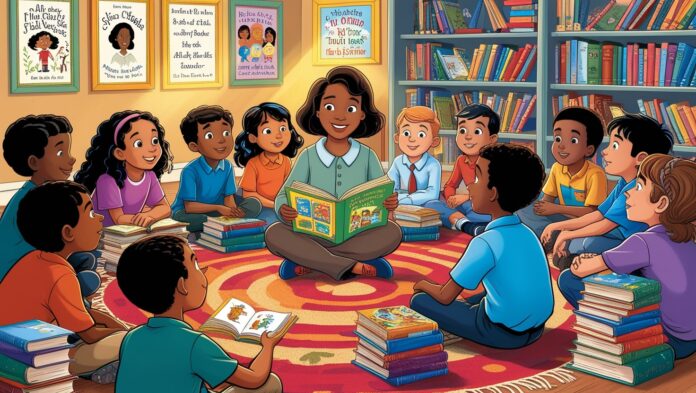
Storytelling is among the oldest forms of communication. Before the written word, stories were used to transmit knowledge, traditions and values from one generation to another. In today’s world, storytelling plays an important role, especially in education. It helps simplify complex ideas, engages students, and fosters a love of learning. Let’s explore the many ways storytelling improves education.
Making Learning Engaging and Fun
One of the main benefits of storytelling in education is that it makes learning more interesting and fun. When teachers tell stories, they capture students’ attention. Stories have a natural way of drawing us to ourselves. We get curious about what’s next, and that curiosity keeps us engaged. For example, learning about history through the stories of real people and events brings the past alive. Instead of just memorizing dates and facts, students can feel the excitement, challenges, and emotions of the people who lived in those times.
Simplifying Complex Ideas
Many subjects in school can seem complicated and overwhelming to students. There are concepts in math, science, and even grammar that can be difficult to understand. Storytelling helps facilitate these ideas. For example, a story about a farmer who needs to count his sheep introduces basic math concepts in a relevant way. Similarly, a story about the water cycle with characters like “Drappy,” a raindrop, can make learning about evaporation and condensation fun and understandable.
Fostering Imagination and Creativity
Stories stimulate imagination and creativity. When students listen to stories, they picture scenes, characters, and events in their minds. This mental perception strengthens their creativity. Creative thinking is important not only in art but in all aspects of life. Problem solving, innovation, and critical thinking all benefit from a strong imagination. By fostering these skills through storytelling, education prepares students for greater challenges and opportunities.
Building Emotional Connections
educational Stories have the power to the connect emotionally with us . They can make us laugh, cry, feel excited, or even scared. These emotional connections make learning more memorable. When students feel a strong emotional connection to a story, they are more likely to remember the lessons it teaches. For example, a story about a teenage girl’s journey to overcome obstacles can teach perseverance and resilience in a way that a simple lecture cannot.
Enhancing Language Skills
Storytelling naturally enhances language skills. Listening to stories helps students develop listening skills and understand the rhythm and flow of language. When students listen to the stories again, they practice speaking and organizing their thoughts. Writing your own stories encourages creativity and improves writing skills. Additionally, stories often introduce new words, making it easier for students to understand and remember new words.
Encouraging Empathy and Understanding
Through stories, students can step into someone else’s shoes and see the world from a different perspective. This encourages empathy and understanding. For example, reading stories from different cultures helps students appreciate diversity and develop a broader worldview. They learn to respect and value the experiences and opinions of others. This is essential in today’s interconnected world, where understanding and cooperation are key to addressing global challenges.

Supporting Social and Emotional Learning
Storytelling supports social and emotional learning (SEL), which focuses on developing skills such as self-awareness, self-management, social awareness, relationship skills, and responsible decision-making. Stories can illustrate these skills in action. For example, a story about a character dealing with a difficult situation shows how to manage emotions and make good decisions. Discussing role choices and actions helps students reflect on their own experiences and develop their SEL skills.
Encouraging a Love for Reading
Writing a story can create a love for reading. When students hear an interesting story, they often want to read more stories like it. This desire can motivate them to read more books, improve their reading skills and expand their knowledge. Teachers and parents can foster this love of reading by sharing a wide range of stories and encouraging students to explore different genres and authors.
Bringing Subjects to Life
Stories bring themes to life by connecting them to real-life experiences. For example, a science lesson about ecosystems can be combined with a rainforest adventure story. It makes the topic more relevant and interesting. Students see practical applications of what they are learning and understand its relevance to their own lives. This connection to real-life experiences can increase their motivation and enthusiasm for learning.
Promoting Critical Thinking and Problem-Solving
Many stories present characters with challenges or problems to deal with. As students follow the story, they think about how they would handle the situation. It promotes critical thinking and problem solving skills. Discussing the story allows students to analyze the characters’ decisions and consider alternative solutions. These discussions help develop the ability to think and make informed decisions.
Strengthening Cultural Awareness
Storytelling is a powerful way to share and preserve cultural heritage. By hearing stories from different cultures, students gain a deeper understanding and respect for cultural diversity. They learn about different traditions, values and ways of life. This cultural awareness is essential to foster a more inclusive and harmonious society. It helps students appreciate the richness of the world’s cultures and recognize the common humanity that connects us all.
Enhancing Memory and Retention
Stories are easier to remember than isolated facts. They provide a context that makes the information more memorable. For example, a story about the discovery of electricity sticks with students longer than a list of scientific terms and definitions. This improved memory and retention helps students build a solid foundation of knowledge that they can build on in their future studies and life.
Conclusion
Storytelling is a powerful tool in education. It makes learning engaging and fun, simplifies complex ideas, fosters imagination and creativity, creates emotional connections, enhances language skills, and encourages empathy and understanding. It supports social and emotional learning, fosters a love of reading, brings subjects to life, fosters critical thinking and problem solving, strengthens cultural awareness, and enhances memory and retention. By incorporating storytelling into education, teachers can create a more dynamic, inclusive, and effective learning environment that prepares students for success in all areas of life.

FAQs frequently asked questions about the role of storytelling in education:
1. How can storytelling be incorporated into different subjects?
Answer: Storytelling can be used in virtually any subject to make lessons more engaging and relatable. For example:
- History: Use stories about historical figures or events to bring the past to life.
- Science: Create narratives around scientific discoveries or experiments, such as a story about a scientist’s journey to uncover a new phenomenon.
- Math: Develop stories involving characters who solve problems or face mathematical challenges, making abstract concepts more concrete.
- Literature: Analyze and create stories to explore themes, character development, and plot structure.
- Social Studies: Share stories from different cultures or communities to foster understanding and appreciation.
2. What are the benefits of storytelling for young children in education?
Answer: For young children, storytelling offers several benefits:
- Language Development: It enhances vocabulary, listening skills, and comprehension.
- Cognitive Skills: Stories help children understand cause and effect, sequence of events, and problem-solving.
- Emotional Development: They learn about different emotions and how to manage them by identifying with characters in the stories.
- Creativity: Storytelling stimulates imagination and encourages creative thinking.
3. Can storytelling be used effectively in higher education and adult learning?
Answer: Yes, storytelling can be very effective in higher education and adult learning. For instance:
- Case Studies: In business or law, storytelling through case studies helps illustrate complex concepts and real-world applications.
- Lectures: Professors can use stories to contextualize information and make lectures more engaging.
- Professional Development: Sharing success stories or challenges faced in the field can inspire and provide practical insights.
4. How does storytelling enhance critical thinking and problem-solving skills?
Answer: Storytelling enhances critical thinking and problem-solving by:
- Presenting Challenges: Stories often involve characters facing dilemmas or obstacles, encouraging students to think about solutions.
- Encouraging Analysis: Students analyze characters’ decisions and outcomes, discussing what could have been done differently.
- Promoting Reflection: Reflecting on stories helps students apply lessons learned to their own problem-solving processes.
5. What are some strategies for using storytelling in the classroom?
Answer: Effective strategies for incorporating storytelling in the classroom include:
- Interactive Storytelling: Engage students by involving them in the story, asking questions, and encouraging them to contribute ideas.
- Storytelling Tools: Use visual aids, props, or digital media to enhance the storytelling experience.
- Student Stories: Encourage students to create and share their own stories related to the lesson.
- Connect to Curriculum: Ensure that the stories align with learning objectives and help illustrate key concepts.
- Diverse Perspectives: Include stories from different cultures and backgrounds to broaden students’ understanding and empathy.

